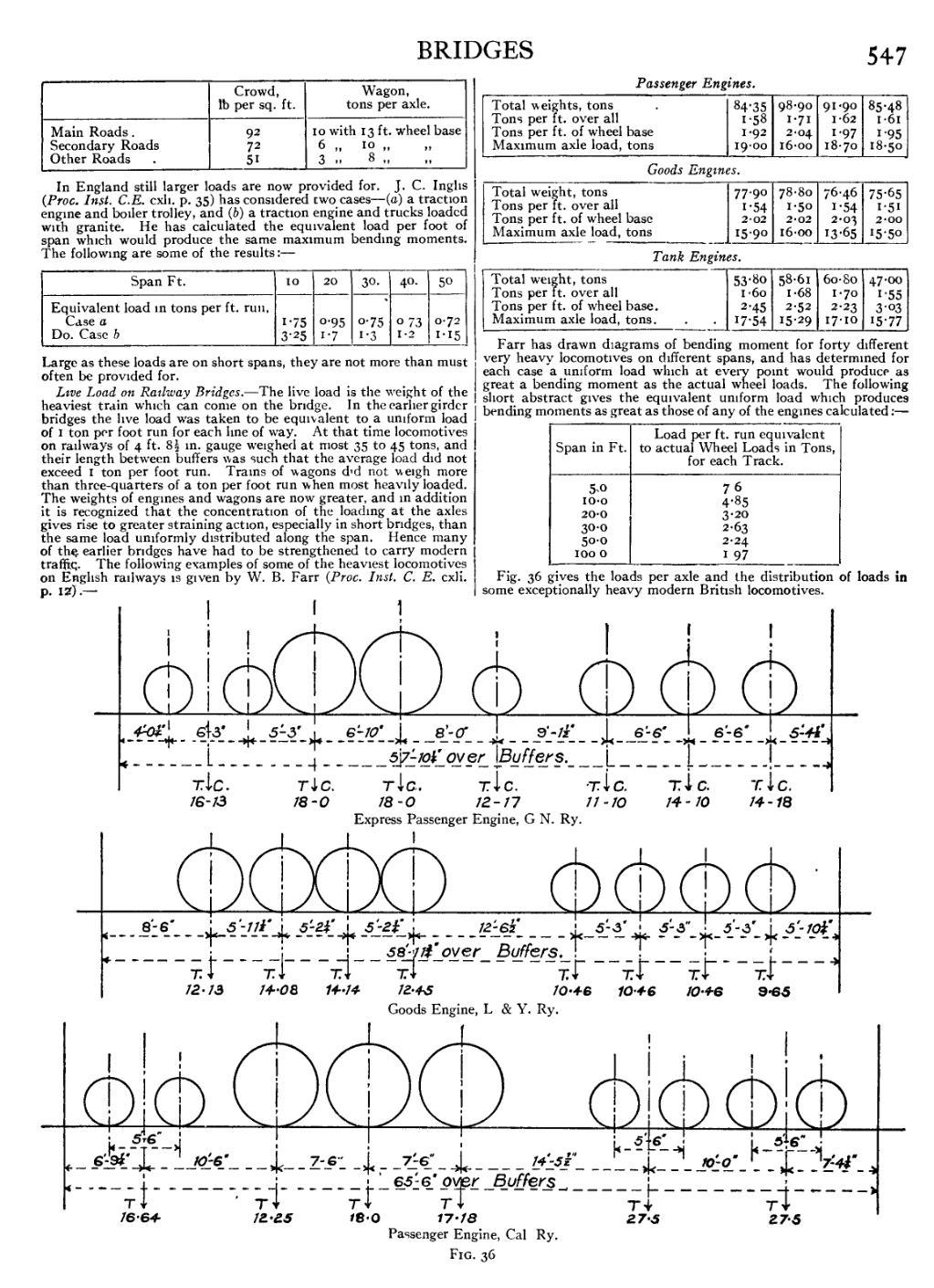| Crowd, ℔ per sq. ft. | Wagon, tons per axle. | |
| Main Roads | 92 | 10 with 13 ft. wheel base |
| Secondary Roads | 72 | 6 with 10 ft. wheel base |
| Other Roads | 51 | 3 with 8 ft. wheel base |
In England still larger loads are now provided for. J. C. Inglis (Proc. Inst. C.E. cxli. p. 35) has considered two cases—(a) a traction engine and boiler trolley, and (b) a traction engine and trucks loaded with granite. He has calculated the equivalent load per foot of span which would produce the same maximum bending moments. The following are some of the results:—
| Span Ft. | 10. | 20. | 30. | 40. | 50. |
| Equivalent load in tons per ft. run, Case a | 1.75 | 0.95 | 0.70 | 0.73 | 0.72 |
| Do. Case b | 3.25 | 1.7 | 1.3 | 1.2 | 1.15 |
Large as these loads are on short spans, they are not more than must often be provided for.
Live Load on Railway Bridges.—The live load is the weight of the heaviest train which can come on the bridge. In the earlier girder bridges the live load was taken to be equivalent to a uniform load of 1 ton per foot run for each line of way. At that time locomotives on railways of 4 ft. 81/2 in. gauge weighed at most 35 to 45 tons, and their length between buffers was such that the average load did not exceed 1 ton per foot run. Trains of wagons did not weigh more than three-quarters of a ton per foot run when most heavily loaded. The weights of engines and wagons are now greater, and in addition it is recognized that the concentration of the loading at the axles gives rise to greater straining action, especially in short bridges, than the same load uniformly distributed along the span. Hence many of the earlier bridges have had to be strengthened to carry modern traffic. The following examples of some of the heaviest locomotives on English railways is given by W. B. Farr (Proc. Inst. C.E. cxli. p. 12):—
| Total weights, tons | 84.35 | 98.90 | 91.90 | 85.48 |
| Tons per ft. over all | 1.58 | 1.71 | 1.62 | 1.61 |
| Tons per ft. of wheel base | 1.92 | 2.04 | 1.97 | 1.95 |
| Maximum axle load, tons | 19.00 | 16.00 | 18.70 | 18.50 |
| Total weight, tons | 77.90 | 78.80 | 76.46 | 75.65 |
| Tons per ft. over all | 1.54 | 1.50 | 1.54 | 1.51 |
| Tons per ft. of wheel base | 2.02 | 2.02 | 2.03 | 2.00 |
| Maximum axle load, tons | 15.90 | 16.00 | 13.65 | 15.50 |
| Total weight, tons | 53.80 | 58.61 | 60.80 | 47.00 |
| Tons per ft. over all | 1.60 | 1.68 | 1.70 | 1.55 |
| Tons per ft. of wheel base | 2.45 | 2.52 | 2.23 | 3.03 |
| Maximum axle load, tons | 17.54 | 15.29 | 17.10 | 15.77 |
Farr has drawn diagrams of bending moment for forty different very heavy locomotives on different spans, and has determined for each case a uniform load which at every point would produce as great a bending moment as the actual wheel loads. The following short abstract gives the equivalent uniform load which produces bending moments as great as those of any of the engines calculated:—
| Span in Ft. | Load per ft. run equivalent to actual Wheel Loads in Tons, for each Track. |
| 5.0 | 7.6 |
| 10.0 | 4.85 |
| 20.0 | 3.20 |
| 30.0 | 2.63 |
| 50.0 | 2.24 |
| 100.0 | 1.97 |
Fig. 36 gives the loads per axle and the distribution of loads in some exceptionally heavy modern British locomotives.

Express Passenger Engine, G. N. Ry.

Goods Engine, L. & Y. Ry.

Passenger Engine, Cal. Ry.
Fig. 36.

